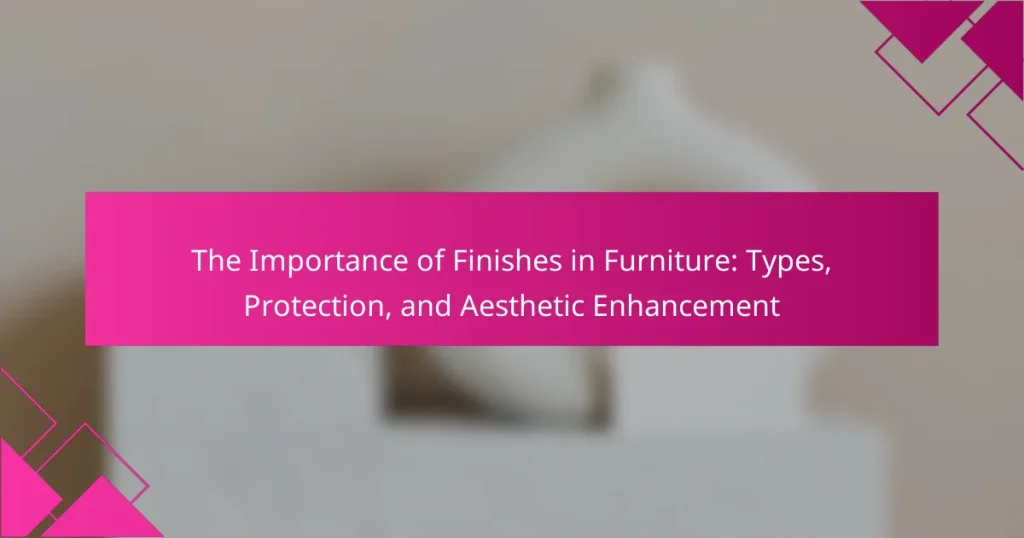Furniture finishes are essential coatings that enhance the appearance, protection, and longevity of furniture. This article explores various types of finishes, including varnish, lacquer, oil, polyurethane, and shellac, detailing their unique properties and effects on wood. It emphasizes the importance of protection against moisture, dirt, and damage, highlighting how finishes can extend the lifespan of furniture while maintaining its aesthetic appeal. Additionally, the article discusses how different finishes contribute to the visual quality of furniture, influencing perceived value and overall design. Understanding these factors is crucial for making informed choices in furniture care and enhancement.

What are the Different Types of Finishes in Furniture?
The different types of finishes in furniture include varnish, lacquer, oil, polyurethane, and shellac. Varnish is a durable finish that provides a hard surface and enhances wood’s natural beauty. Lacquer dries quickly and offers a high-gloss appearance. Oil finishes penetrate the wood, providing a natural look and feel. Polyurethane is a synthetic finish known for its resistance to water and scratches. Shellac is a natural resin that offers a warm tone and is easy to repair. Each finish has unique properties that affect the appearance and durability of furniture.
How do various finishes impact the durability of furniture?
Various finishes significantly impact the durability of furniture. Different finishes provide varying levels of protection against wear, moisture, and UV damage. For example, polyurethane finishes create a hard, protective layer that resists scratches and spills. Oil-based finishes penetrate the wood, enhancing its natural beauty while providing moderate protection. Water-based finishes dry quickly and are less toxic, but may offer less durability compared to oil-based options. Additionally, lacquer finishes provide a high-gloss surface that is resistant to scratches but can be less heat resistant. The choice of finish directly influences the lifespan of the furniture, as some finishes can extend durability by years when properly applied.
What are the characteristics of oil-based finishes?
Oil-based finishes are protective coatings derived from oils that enhance the appearance of wood. They penetrate deeply into the wood grain, providing a rich, warm glow. These finishes offer durability and resistance to moisture and wear. They are known for their ability to highlight the natural beauty of the wood. Oil-based finishes dry slowly, allowing for a smooth application. They typically require multiple coats for optimal protection. Cleanup requires solvents like mineral spirits due to their chemical composition. Overall, oil-based finishes are favored for their long-lasting results and aesthetic appeal.
How do water-based finishes differ from solvent-based finishes?
Water-based finishes differ from solvent-based finishes primarily in their composition and drying time. Water-based finishes use water as the primary solvent, while solvent-based finishes use organic solvents. This difference affects their environmental impact; water-based finishes are generally less toxic and have lower volatile organic compound (VOC) emissions.
Drying times also vary significantly. Water-based finishes typically dry faster, allowing for quicker application of multiple coats. Solvent-based finishes, on the other hand, take longer to dry and cure. The application process is influenced by these drying times; water-based finishes can be easier to work with for quick projects.
Additionally, the final appearance can differ. Water-based finishes tend to have a clearer, less amber tone compared to solvent-based finishes, which can impart a warmer hue. This characteristic can influence the aesthetic outcome on different wood types.
In summary, the key differences lie in composition, drying time, toxicity, and final appearance.
What are the aesthetic benefits of different finishes?
Different finishes enhance the aesthetic appeal of furniture by providing varied textures, colors, and sheens. A glossy finish reflects light, creating a modern and polished look. Matte finishes offer a soft, understated appearance that can add warmth. Stained finishes can highlight the wood grain, enriching the natural beauty of the material. Distressed finishes provide a rustic or vintage charm, appealing to specific design preferences. Each finish contributes to the overall style, making it essential for aligning with interior design themes. For instance, a high-gloss finish may suit contemporary spaces, while a distressed finish may complement farmhouse aesthetics.
How does a matte finish compare to a glossy finish in appearance?
A matte finish has a non-reflective surface, while a glossy finish is shiny and reflective. Matte finishes absorb light, resulting in a softer, understated appearance. In contrast, glossy finishes reflect light, creating a vibrant and striking look. Matte surfaces tend to hide imperfections better than glossy ones, which can highlight flaws. Glossy finishes are often perceived as more modern and sleek, while matte finishes convey a more traditional or rustic feel. The choice between the two can significantly affect the overall aesthetic of furniture.
What role do finishes play in enhancing wood grain visibility?
Finishes enhance wood grain visibility by adding depth and clarity to the surface. They can highlight the natural patterns and colors of the wood. Different finishes, such as oils, varnishes, and stains, affect how light interacts with the grain. For instance, an oil finish penetrates the wood, enriching its color and enhancing the grain’s appearance. In contrast, a clear varnish can provide a glossy surface that reflects light, further accentuating the grain. According to a study by the Forest Products Laboratory, certain finishes can increase the contrast of wood grain by up to 30%. This makes the grain more visually appealing and pronounced.

Why is Protection Important in Furniture Finishes?
Protection is important in furniture finishes to preserve the integrity and appearance of the furniture. Finishes act as a barrier against moisture, dirt, and physical damage. Without protection, wood can warp, crack, or suffer from discoloration. Protective finishes also enhance durability, extending the lifespan of the furniture. For example, UV protection prevents fading from sunlight exposure. Additionally, finishes can resist stains and scratches, maintaining the furniture’s aesthetic appeal. Research shows that well-finished furniture can last significantly longer than unprotected pieces. Thus, protection in furniture finishes is essential for both functionality and visual quality.
How do finishes protect furniture from environmental damage?
Finishes protect furniture from environmental damage by creating a barrier against moisture, UV rays, and contaminants. These protective coatings can be made from various materials such as varnish, lacquer, or oil. Moisture can cause wood to swell or warp, but finishes seal the surface to prevent water absorption. UV rays can lead to fading and discoloration, while finishes contain UV inhibitors that block harmful light. Additionally, finishes repel dust and dirt, making cleaning easier and reducing wear. Research shows that properly finished furniture lasts significantly longer than unfinished pieces, confirming the effectiveness of these protective layers.
What types of wear and tear can finishes prevent?
Finishes can prevent various types of wear and tear on furniture. They protect surfaces from scratches and dents caused by daily use. Finishes also guard against moisture damage, which can lead to warping or swelling. Additionally, they help resist stains from spills, keeping the furniture looking clean. Ultraviolet (UV) protection is another benefit, preventing fading from sunlight exposure. Furthermore, finishes can deter dust accumulation, making maintenance easier. Overall, finishes enhance durability and longevity of furniture by providing essential protective barriers.
How do finishes guard against moisture and stains?
Finishes guard against moisture and stains by creating a protective barrier on surfaces. This barrier prevents liquids from penetrating the material. Common finishes include varnishes, lacquers, and sealants. These products are designed to be water-resistant and stain-resistant. For example, polyurethane finishes provide a strong, waterproof layer. Additionally, oil-based finishes can repel moisture due to their composition. The effectiveness of these finishes is often tested in real-world conditions. Surfaces treated with high-quality finishes show significantly less damage from spills and humidity. This protection extends the lifespan of furniture and maintains its appearance.
What is the lifespan of different furniture finishes?
The lifespan of different furniture finishes varies significantly. Oil finishes typically last 1 to 3 years before requiring reapplication. Varnish finishes can endure 5 to 10 years, depending on usage and maintenance. Lacquer finishes may last around 3 to 5 years, while polyurethane finishes can last 10 years or more. Stain finishes generally require reapplication every 3 to 5 years. These lifespans depend on factors such as exposure to sunlight, humidity, and frequency of use. Regular maintenance can extend the life of any finish significantly.
How can proper maintenance extend the life of furniture finishes?
Proper maintenance can significantly extend the life of furniture finishes. Regular cleaning prevents the buildup of dirt and grime that can damage the finish. Using appropriate cleaning products, such as pH-balanced solutions, helps maintain the integrity of the finish. Additionally, applying protective coatings, like wax or polish, can create a barrier against moisture and scratches. This barrier reduces the risk of wear and tear over time. Furthermore, avoiding direct sunlight can prevent fading and discoloration of finishes. Keeping furniture in a controlled environment with stable humidity levels also minimizes the risk of cracking or peeling. These maintenance practices collectively enhance the durability and appearance of furniture finishes.
What factors affect the durability of a furniture finish?
The durability of a furniture finish is affected by several key factors. These include the type of finish used, environmental conditions, and application methods. Different finishes, such as varnish, lacquer, or oil, have varying levels of hardness and resistance to wear. Environmental factors like humidity and temperature fluctuations can lead to expansion and contraction, compromising the finish. Proper application techniques, including surface preparation and curing time, also play a crucial role in the finish’s longevity. For instance, finishes that are not allowed to cure properly may peel or chip more easily. Additionally, exposure to sunlight can cause fading and degradation over time. Understanding these factors helps in selecting the right finish for enhanced durability.

How Can Finishes Enhance the Aesthetic Appeal of Furniture?
Finishes enhance the aesthetic appeal of furniture by adding color, texture, and sheen. They can transform a plain piece into a visually striking item. Different finishes, such as stains, paints, and varnishes, provide various visual effects. For instance, a glossy finish can reflect light, making furniture appear more vibrant. Conversely, a matte finish offers a subtle, understated look. Finishes also protect the underlying material, preserving its appearance over time. Research indicates that well-finished furniture can increase perceived value by up to 30%. Therefore, the choice of finish is crucial for both beauty and longevity in furniture design.
What are the psychological effects of different finish colors and textures?
Different finish colors and textures have distinct psychological effects on individuals. Bright colors like yellow and orange can evoke feelings of happiness and energy. Soft colors such as blue and green are often associated with calmness and relaxation. Textures also play a role; smooth finishes can create a sense of sophistication, while rough textures may evoke feelings of warmth and comfort.
A study by Küller et al. (2006) found that color significantly influenced emotional responses in a controlled environment. Additionally, research by E. J. M. van der Laan et al. (2012) indicated that texture impacts perceived comfort and safety. These findings support the idea that both color and texture in finishes can shape emotional experiences and perceptions in a space.
How do finishes influence the overall style of a room?
Finishes significantly influence the overall style of a room by affecting its visual appeal and texture. Different finishes can create distinct atmospheres, such as modern, rustic, or traditional. For example, a glossy finish may evoke a contemporary look, while a matte finish can convey warmth and coziness. The choice of finish also impacts how light interacts with surfaces, enhancing or diminishing brightness in a space. Textured finishes add depth and interest, contributing to a layered design. Additionally, finishes can harmonize or contrast with other design elements, influencing color schemes and furniture styles. Ultimately, the right finish can unify a room’s aesthetic and enhance its overall character.
What trends are emerging in furniture finishes for aesthetic enhancement?
Natural finishes are emerging as a significant trend in furniture aesthetics. These finishes highlight the wood’s inherent beauty and grain patterns. Minimalist designs are also gaining popularity, focusing on simplicity and clean lines. Matte and satin finishes are preferred over high-gloss options for a more understated look. Sustainable materials are increasingly used, aligning with eco-friendly consumer preferences. Textured finishes, such as wire-brushed or distressed looks, add depth and character. Bold colors and unique stains are being applied to create statement pieces. Customization options are on the rise, allowing consumers to personalize their furniture.
What practical tips can be applied for selecting the right finish?
Consider the function and location of the furniture piece when selecting a finish. Different environments require different durability levels. For example, outdoor furniture needs weather-resistant finishes. Assess the wood type, as some finishes work better with specific woods. Test samples on a small area to see the final appearance. Evaluate the sheen level; high gloss enhances colors while matte offers a subtle look. Research the application process; some finishes require multiple coats or special tools. Finally, consider maintenance; some finishes need more upkeep than others.
How can one determine the best finish for a specific type of furniture?
To determine the best finish for a specific type of furniture, consider the material and usage. Different materials require different finishes for optimal protection and appearance. For example, wood furniture often benefits from oil-based finishes for durability.
Evaluate the environment where the furniture will be used. High-moisture areas may need water-resistant finishes. Assess the desired aesthetic as well. Glossy finishes enhance color depth, while matte finishes offer a more subdued look.
Test samples on a small area of the furniture. This helps visualize the final appearance and ensures compatibility with the material. Research specific finishes for the furniture type, as certain combinations may yield superior results.
What common mistakes should be avoided when applying finishes?
Common mistakes to avoid when applying finishes include inadequate surface preparation. Failing to clean and sand the surface can lead to poor adhesion. Another mistake is applying finishes in unsuitable environmental conditions. High humidity or low temperatures can affect drying and curing times. Additionally, over-applying the finish can create a thick, uneven coat. It’s also important to avoid using the wrong application tools. Brushes, rollers, or sprays should be chosen based on the finish type. Not allowing sufficient drying time between coats can result in a compromised finish. Lastly, neglecting to read and follow the manufacturer’s instructions can lead to undesirable results.
The main entity of this article is furniture finishes, which play a crucial role in enhancing the durability and aesthetic appeal of furniture. The article provides an overview of various types of finishes, including varnish, lacquer, oil, polyurethane, and shellac, highlighting their unique properties and effects on furniture longevity. It also discusses the impact of finishes on wood grain visibility, moisture protection, and the overall style of a room. Additionally, practical tips for selecting the appropriate finish based on material and usage, as well as common mistakes to avoid during application, are covered to ensure optimal results.


